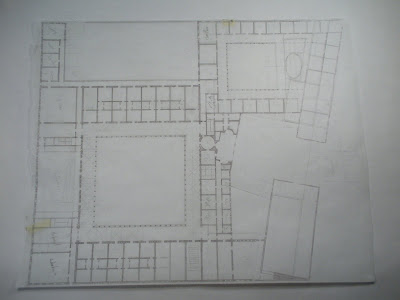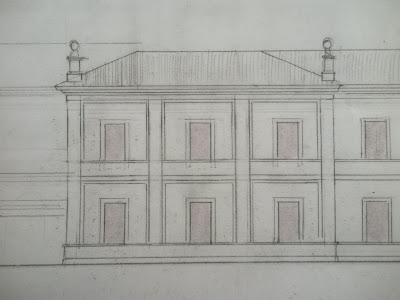What does Alberti mean by concinnitas? How does he learn what it is so that he can introduce it into his building? and what role, then, does concinnitas play in investing a building with beauty?Concinnitas, Alberti’s powerful term for “the absolute and fundamental rule of Nature” denotes, with such a description and by its very nature, a difficult, and illusive theory. While Alberti makes no more specific statement than that concinnitas composes parts “according to some precise rule,” the very framework in which concinnitas is conceived will help the thoughtful architect, philosopher or political thinker in its pursuit, for concinnitas is more than a mere pattern book rule to be followed. Rather it is the way in which Beauty is reconciled to the particular example on earth. Concinnitas translates the ineffable idea of Beauty to us through minute adjustment of proportion, thereby rendering it perceptible to the senses. The pursuit of concinnitas is the highest goal of the architect, or indeed of man in general.
“Everything that Nature produces is regulated by the law of concinnitas, and her chief concern is that whatever she produces should be absolutely perfect.” Concinnitas flourishes in birth and death, in creation and destruction, and in every changing state between these extremes. Indeed, there can be no written formula for such an idea because it is not a static result, but a defining action whose very meaning is to take parts which are in every case different, and arrange them such that they form through their correspondence a complete and perfect whole. Concinnitas is the final and defining quality of architecture, or art in general. As such, it surpasses the crude necessities of shelter and protection, enters the realm beauty, and becomes something that arouses delight in the beholder.
Thus, a discussion of concinnitas must begin with the understanding that it is something which governs both the practical and aesthetic qualities of building; it is behind and above decisions concerning the material or order of building. What Alberti is telling us is that no truly functional thing can be made without concinnitas, and that any discussion of concinnitas must therefore govern and surpass that of firmness and commodity. Architecture, Alberti tells us, in agreement with Vitruvius, is worthy of praise when it is commodious, firm, and delightful. Yet for Alberti, the final requirement is the most vital. “Of the three conditions that apply to every form of construction – that what we construct should be appropriate to its use, lasting in structure, and graceful and pleasing in its appearance – the first two have been dealt with and there remains the third, the noblest and most necessary of all.” In other words, firmness and commodity are necessities not just of a palazzo, but also of a barn. What sets great buildings apart is that they delight our senses with the beauty arising from their proportions, not just relative to themselves, but to the cosmos.
“All care”, he tells us, “all diligence, all financial consideration must be directed to ensuring that what is to built is useful, commodious, yes – but also embellished and wholly graceful, so that anyone seeing it would not feel that the expense might have been invested better elsewhere.” Thus, architecture for Alberti is most concerned with beauty, in that every good which architecture brings to humanity is a result of its grace and appropriateness. “To have satisfied necessity is trite and insignificant, to have catered to convenience unrewarding when the inelegance in a work causes offense.” The task of the architect is to reach beyond necessity and evoke pleasure in the viewer. This is accomplished through concinnitas.
Central to Alberti’s theory of concinnitas is the idea that architecture is a composition of various individual parts that follows a rational arrangement. Beauty, Alberti tells us, “is that reasoned harmony of all the parts within a body, so that nothing may be added, taken away, or altered, but for the worse." It is in the correct manipulation of these elements that beauty is achieved. “When you make judgments on beauty, you do not follow mere fancy, but the workings of a reasoned faculty that is inborn in the mind… for every body consists entirely of parts that are fixed and individual; if these are removed, enlarged, reduced, or transferred somewhere inappropriate, the very composition will be spoiled that gives the body its seemly appearance.”
The theory of concinnitas is grounded in a perfect composition of the various parts. If these elements such as cornices, windows, walls, columns, doors, and porticoes are altered from their perfect manifestation in the whole, concinnitas will no longer be present in the work. Indeed, one might also say that, just as a “reasoning faculty is in born in the mind,” so too a “natural excellence” exists as a potential in every building. The individual building in this description already exists as a perfect idea which the art of the architect attempts to emulate. In other words, a failure to correctly arrange the parts according to the rules of concinnitas regulating the composition of the whole will results in an unsuccessful building, or one that does not attain the perfection it is innately capable of.
How then do we achieve this proportionate arrangement? If beauty is the reasoned harmony of all the parts, then that harmony may be described, Alberti tells us, using Number, Outline and Position. For Alberti number was a quantitative relationship between things in a formula, but more importantly, it was also a qualitative entity in its own right. As George Hersey so beautifully explains there were whole churches, cities, kingdoms and heavens of numbers, each with its own particular character and even genealogical structure. Outline is difficult to understand as it can mean several things. I believe it is directly tied to Alberti's idea of lineamente, or the lines and angles, which form the building (as opposed to the material, or structura). Regardless, it is something like the form, or type of the building, in that in the outline informs us of the building's purpose (to some degree this is also accomplished by ornament). Branko Mitrovic has called lineamente shape, which I think is not far from the truth. Position has to do with Alberti's use of the term collocation, or the placement of the parts of a body in such a relationship that the whole, which they form, has the quality of beauty. We will return to this.
“But,” Alberti continues, “arising from the composition and connection of these three is a further quality in which beauty shines full face: our term for this is Concinnitas; which we say is nourished with every grace and splendor. It is the task and aim of concinnitas to compose parts that are quite separate from each other by their nature, according to some precise rule, so that they correspond to one another in appearance.” In other words, concinnitas takes varying numbers of things which have different shapes, and lie in various positions, and creates (according to a “precise rule”) a complete and beautiful whole.
Concinnitas is not simple the combination of number shape and position, or a glorification of just of position, rather it is the manipulation of the three qualities such that each is altered to form a suitable and distinct whole, appropriate for its unique location and purpose on earth. To make this distinction more apparent, let us even say that position is sufficient to compose a literal version of a building’s heavenly counterpart, but that concinnitas breaths the life into an otherwise inanimate copy. Concinnitas fractures the perfect harmony of ideal beauty just enough for man to comprehend it. In short, concinnitas is like the bending of a perfect rectangle to fit the curvature of the globe it would otherwise be incompatible with.








 Possible Negrini tank? It's longer and narrower than the old tank, and very pretty. It's just not finished at all, so I would have to have take care of that. The old tank is so unique with its polished steel and clear powdercoat, but to go through that whole process again with the Negrini tank.. Ughh.
Possible Negrini tank? It's longer and narrower than the old tank, and very pretty. It's just not finished at all, so I would have to have take care of that. The old tank is so unique with its polished steel and clear powdercoat, but to go through that whole process again with the Negrini tank.. Ughh. The frame is now longer than that of a Magnum, and has 16" wheels compared to a Magnum's 17" wheels. In other words, it looks long. At least I have enough room to run a front fender without taking off my sparkpug boot! I wonder how the handling will be affected.
The frame is now longer than that of a Magnum, and has 16" wheels compared to a Magnum's 17" wheels. In other words, it looks long. At least I have enough room to run a front fender without taking off my sparkpug boot! I wonder how the handling will be affected.